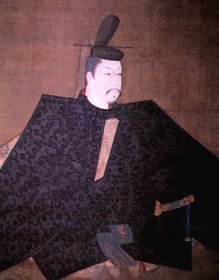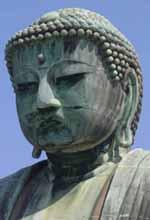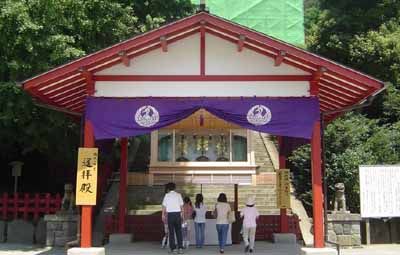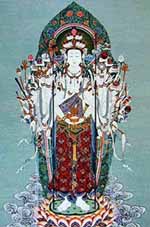Kamakura Period
|
|
|||||||||||||||||||||||||||||||||||||||||||||||||||||||||||||||||||||||||||||||||||||||||||||||||||
BEGINNING | CULTURAL ACHIVEMENTS | DAIBUTSU | TSURUGAOKA HACHIMANGU | HASE TEMPLE | SAMURAI |MONGOL INVASION | END OF KAMAKURA PERIOD
 The
Kamakura Period began in 1192 with the appointment of Minamoto Yoritomo (at
left) as shogun.
He established the Kamakura Bakufu.
This was Japan's first military government. This new government was located
in the eastern town of Kamakura and controlled the area through appointed
governors and stewards. Kamakura is
south of Tokyo located on the Kamakura is located on Miura Peninsula between
Tokyo Bay and Sagami Bay. Upon his death in 1199, fighting broke out between
the new Kamakura government and the imperial government in Kyoto. In Japanese
history, this fighting is referred to as the Jokyu disturbance. It ended in
1221 when Kamakura defeated the Imperial
army in Kyoto giving them control over all of Japan. The emperor and the court
in Kyoto lost almost all effective power at this time. This period of time
in Japanese history is often referred to as its medieval
period. The term feudalism is liberally
used to discribe the government and it is often compared to the European medieval
period.
The
Kamakura Period began in 1192 with the appointment of Minamoto Yoritomo (at
left) as shogun.
He established the Kamakura Bakufu.
This was Japan's first military government. This new government was located
in the eastern town of Kamakura and controlled the area through appointed
governors and stewards. Kamakura is
south of Tokyo located on the Kamakura is located on Miura Peninsula between
Tokyo Bay and Sagami Bay. Upon his death in 1199, fighting broke out between
the new Kamakura government and the imperial government in Kyoto. In Japanese
history, this fighting is referred to as the Jokyu disturbance. It ended in
1221 when Kamakura defeated the Imperial
army in Kyoto giving them control over all of Japan. The emperor and the court
in Kyoto lost almost all effective power at this time. This period of time
in Japanese history is often referred to as its medieval
period. The term feudalism is liberally
used to discribe the government and it is often compared to the European medieval
period. Several
government and cultural achievements occurred during this time period. For
example, in 1225 the Council of State was established. This provided military
lords the right to exercise authority at Kamakura. In 1232, the first military
code of law, the Joei Code
was adopted. This code was a departure from the Confucian based codes to military
law. It outlined and emphasized the roles and duties of stewards
and constables, provided means for settling
land disputes, and established rules governing inheritances. It also contained
harsh punishments and stayed in effect for over 600 years. The uncertainty
of the time is seen in the literature of the period. Two major works of literature
were written during the Kamakura Period. The first The
Hojoki (An Account of My Hut) describes the vanity of humans and is tied
to Buddhism. The second work, The Heike
monogatari (Tale of the Heike), narrates the rise and fall of the Taira
Clan contains tales of wars and samurai. Poetry also flourished during this
period. Twenty volumes of the Shin kokinshu wakashu (New Collection of Ancient
and Modern Times) were produced between 1201 and 1205.
 During
the Kamakura Period, Buddhism grew greatly. Kamakura became the Buddhist
center
of Japan during this time period. Perhaps the greatest example of the influence
of Buddhism in Kamakura is the Statue of the Great Buddha or Daibutsu.
Made in 1252, it was originally located inside a large temple hall. The
temple
buildings were washed away by a tsunami tidal wave in 1495. The temple is
uphill from the water by over 1 mile. Since then the over forty foot
Buddha,
the second largest in the country, stands in the open air. The statue is
so impressive, Rudyard Kipling was inspired to write a poem
about it. Lady Inadano-Tsubone, a lady attendant of Shogun Yoritomo left
court service after his death and devoted herself to raising funds for the
construction
of the Great Buddha. A wooden image was completed in 1243 but was damaged
by a storm 5 years later. Funding and building of the current bronze state
began shortley afterward. Click Here for
Video of the Inside of The Buddha StatueThis particular statue is modeled
after the usual Indian form of meditation which was adopted by the Japanese
Buddhists particularly
Zen Buddhists. The legs are crossed in front and the body is inclined
slightly forward. Click Here for
External Video of the Statue. Video
Clip #2. The Pure Land Sects grew greatly
during this time period. In addition
to previous Buddhist sects, a radical group emerged. In 1253, The Lotus Sutra
sect was founded by Nichiren Shonin, a Japanese monk who believed the Lotus
Sutra offered the true Buddhism. He went on to write Rissho Ankoku Ron, (Treatise
on Spreading Peace Throughout the Country by Establishing Righteousness).
This work credits the natural disasters that were occurring to the government's
incorrect government and the people who followed the false Buddhist ways.
The criticism of the government led to persecution for the followers. Their
beliefs focused on the scripture The
Lotus Sutra. Click
here to see a guide to Buddhist Temples
During
the Kamakura Period, Buddhism grew greatly. Kamakura became the Buddhist
center
of Japan during this time period. Perhaps the greatest example of the influence
of Buddhism in Kamakura is the Statue of the Great Buddha or Daibutsu.
Made in 1252, it was originally located inside a large temple hall. The
temple
buildings were washed away by a tsunami tidal wave in 1495. The temple is
uphill from the water by over 1 mile. Since then the over forty foot
Buddha,
the second largest in the country, stands in the open air. The statue is
so impressive, Rudyard Kipling was inspired to write a poem
about it. Lady Inadano-Tsubone, a lady attendant of Shogun Yoritomo left
court service after his death and devoted herself to raising funds for the
construction
of the Great Buddha. A wooden image was completed in 1243 but was damaged
by a storm 5 years later. Funding and building of the current bronze state
began shortley afterward. Click Here for
Video of the Inside of The Buddha StatueThis particular statue is modeled
after the usual Indian form of meditation which was adopted by the Japanese
Buddhists particularly
Zen Buddhists. The legs are crossed in front and the body is inclined
slightly forward. Click Here for
External Video of the Statue. Video
Clip #2. The Pure Land Sects grew greatly
during this time period. In addition
to previous Buddhist sects, a radical group emerged. In 1253, The Lotus Sutra
sect was founded by Nichiren Shonin, a Japanese monk who believed the Lotus
Sutra offered the true Buddhism. He went on to write Rissho Ankoku Ron, (Treatise
on Spreading Peace Throughout the Country by Establishing Righteousness).
This work credits the natural disasters that were occurring to the government's
incorrect government and the people who followed the false Buddhist ways.
The criticism of the government led to persecution for the followers. Their
beliefs focused on the scripture The
Lotus Sutra. Click
here to see a guide to Buddhist Temples
 Tsurugaoka
Hachimangu is the most important Shinto shrine in Kamakura. It is dedicated
to Hachiman, the Shinto god of War and the patron god of the Minamoto family,
who founded the shrine in 1063. Hachiman is also the patron god of the
samurai.
It was later enlarged and moved to its current site in 1180 by Minamoto Yoritomo.
The entrance shrine, like most, is marked with red
tori. There are several entrances into the shrine. The West entrance
has many merchants lining the walkway.
The main entrance to the shrine is up a long
walkway
called Wakamiya Oji. It was constructed for Minamoto Yoritomo's oldest son
and his first visit to the shrine. . It is a paved walkway lined with cherry
blossoms making it a favorite tourist attraction in the spring. It is now
in the center of a main road in Kamakura. At the left of the 61 stairs leading
to the main shrine, there is a large gingko
tree.
There is the claim that it is 1000 years old. It however has a sad history.
At that spot in 1219, Minamoto Sanetomo, the third shogun
was stapped to death by his nephew Kygyo. Kygyo, the chief of the Shrine
at the time, hid behind the tree and killed him out of jealousy. He later
committed
seppuku rather than face capture. To
the east of the main shrine, there is a side shrine where many students
make
offerings. Shirahata sub-shrine
is for success in tests. Another shrine,
Hata-age Benzaiten Shrine, is located on an
island amidst lotus flowers. It was originally designed with only white
lotus flowers, the color of the Minamoto family, but has red lotus flowers,
the color of the Taira clan, have mixed in over the years. Benzaiten is believed
to be the Goddess of Fortune, Art and Learning. There individuals can pray
privately with their families hoping to achieve one of the three assets that
the goddess oversees.Click here to see
a video clip of a service. Click
here to see a guide to Shinto Shrines.
Tsurugaoka
Hachimangu is the most important Shinto shrine in Kamakura. It is dedicated
to Hachiman, the Shinto god of War and the patron god of the Minamoto family,
who founded the shrine in 1063. Hachiman is also the patron god of the
samurai.
It was later enlarged and moved to its current site in 1180 by Minamoto Yoritomo.
The entrance shrine, like most, is marked with red
tori. There are several entrances into the shrine. The West entrance
has many merchants lining the walkway.
The main entrance to the shrine is up a long
walkway
called Wakamiya Oji. It was constructed for Minamoto Yoritomo's oldest son
and his first visit to the shrine. . It is a paved walkway lined with cherry
blossoms making it a favorite tourist attraction in the spring. It is now
in the center of a main road in Kamakura. At the left of the 61 stairs leading
to the main shrine, there is a large gingko
tree.
There is the claim that it is 1000 years old. It however has a sad history.
At that spot in 1219, Minamoto Sanetomo, the third shogun
was stapped to death by his nephew Kygyo. Kygyo, the chief of the Shrine
at the time, hid behind the tree and killed him out of jealousy. He later
committed
seppuku rather than face capture. To
the east of the main shrine, there is a side shrine where many students
make
offerings. Shirahata sub-shrine
is for success in tests. Another shrine,
Hata-age Benzaiten Shrine, is located on an
island amidst lotus flowers. It was originally designed with only white
lotus flowers, the color of the Minamoto family, but has red lotus flowers,
the color of the Taira clan, have mixed in over the years. Benzaiten is believed
to be the Goddess of Fortune, Art and Learning. There individuals can pray
privately with their families hoping to achieve one of the three assets that
the goddess oversees.Click here to see
a video clip of a service. Click
here to see a guide to Shinto Shrines.
 Another
temple in Kamakura is the Hase Kannon Temple.
This temple is located closer to the water than the Daibutsu or Tsurugaoka
Hachimangu but on a high hill. It is most famous for its temple dedicated
to Kannon (at right), the goddess of Mercy. There is a carved wooden statue
of Kannon that washed ashore near Kamakura. Legend of this statue centers
around two statues carved from one camphor tree in Hase. One was kept in Hase
and the other was cast into the water to find its own home. It washed ashore
300 miles east but was throne back into the sea when all who touched it received
bad luck or became ill. It washed ashore in Kamakura and gave them no ill
fortune. This was taken as a sign that the statue was at home and the temple
was built. One of the shrines at this temple began as a place for parents
to pray for children. It is dedicated to Jizo, the guardian deity of children.
In the years since World War II, it has become a shrine for children who have
died in miscarriage or abortion. Parents may purchase a clay statue and leave
it in the garden. They are often fitted with hand-knitted caps and sweaters.
Often they will leave sacrifices for the children in the form of small toys
or child favorite foods. Click here to view
video of the statues. A third shrine in the temple is one to Amida,
a Buddha who promised rebirth in the Pure land to the West to all who chanted
his name. Minamoto Yoritomo ordered its construction on his 42nd birthday.
One of the final shrines is a garden cave dedicated
to Benzaiten, the goddess of feminine beauty. The cave is small and marked
with the traditional red tori. Click
here to see a guide to Buddhist Temples. Click
here to see a guide to Shinto Shrines.
Another
temple in Kamakura is the Hase Kannon Temple.
This temple is located closer to the water than the Daibutsu or Tsurugaoka
Hachimangu but on a high hill. It is most famous for its temple dedicated
to Kannon (at right), the goddess of Mercy. There is a carved wooden statue
of Kannon that washed ashore near Kamakura. Legend of this statue centers
around two statues carved from one camphor tree in Hase. One was kept in Hase
and the other was cast into the water to find its own home. It washed ashore
300 miles east but was throne back into the sea when all who touched it received
bad luck or became ill. It washed ashore in Kamakura and gave them no ill
fortune. This was taken as a sign that the statue was at home and the temple
was built. One of the shrines at this temple began as a place for parents
to pray for children. It is dedicated to Jizo, the guardian deity of children.
In the years since World War II, it has become a shrine for children who have
died in miscarriage or abortion. Parents may purchase a clay statue and leave
it in the garden. They are often fitted with hand-knitted caps and sweaters.
Often they will leave sacrifices for the children in the form of small toys
or child favorite foods. Click here to view
video of the statues. A third shrine in the temple is one to Amida,
a Buddha who promised rebirth in the Pure land to the West to all who chanted
his name. Minamoto Yoritomo ordered its construction on his 42nd birthday.
One of the final shrines is a garden cave dedicated
to Benzaiten, the goddess of feminine beauty. The cave is small and marked
with the traditional red tori. Click
here to see a guide to Buddhist Temples. Click
here to see a guide to Shinto Shrines.
The Kamakura Period saw the rise of the samurai. These warriors were bound by loyalty to their daimyo. During this time, the samurai began to carry two swords. The samurai began to follow a code of conduct called bushido. Among their duties to the lord were giving up their lives without hesitation. If they failed, seppuku was the only way for them to regain their honor. When Zen Buddhism was introduced, it appealed to the samurai.
During
the Kamakura Period, The Mongols attempted to invade Japan twice. The first
invasion in 1274, saw the Mongols lose. In 1282, a typhoon
destroyed the Mongol invasion fleet. Japanese believed that the gods
had sent the typhoons to protect their
islands. This is the origin of the kamikaze
myth. The term kamikaze is again used
in Japanese history during World War II.
The end of the Kamakura period came in 1333. SInce 1331, there had been a rebellion in Kyoto called Genko Rebellion. In 1336, Takauji joined the banished Emperor Godaigo. They then attacked the government in Kyoto and Kamakura ending the Kamakura Period ushering in the Muromachi Period and control of Ashikaga Shogunate.
to return to Mrs. O'Donnell's Home Page.
"Maintained according to the Lakeland
Central School District Web Page Policies and Guidelines."
“Clicking on the above links will direct you to site(s) outside the Lakeland
Central School District and the Lakeland High School server. The Lakeland Central
School District is not responsible for contents on external sites and servers,
nor does the district endorse the sponsors or advertising on these sites.” This
site was designed and maintained by Maureen
O'Donnell, a teacher at Lakeland
High School.
July 2005 Created - |
Saturday, February 25, 2006
Last Revised -













